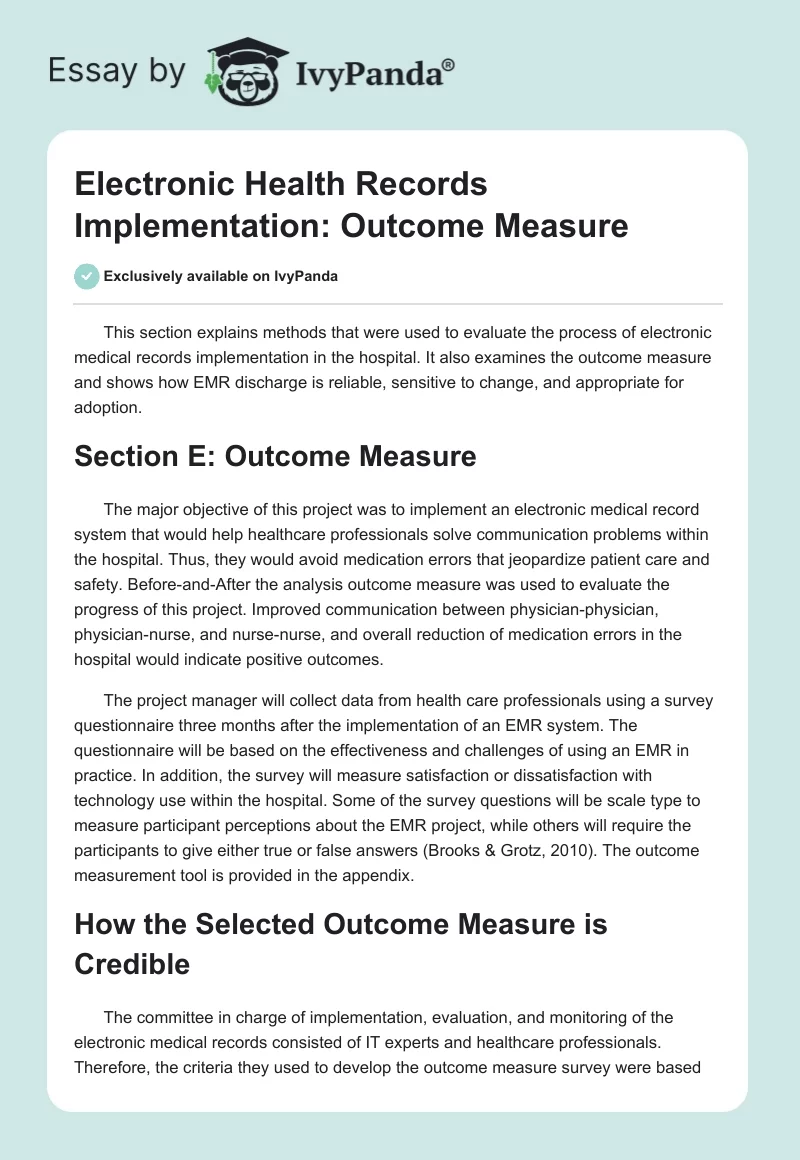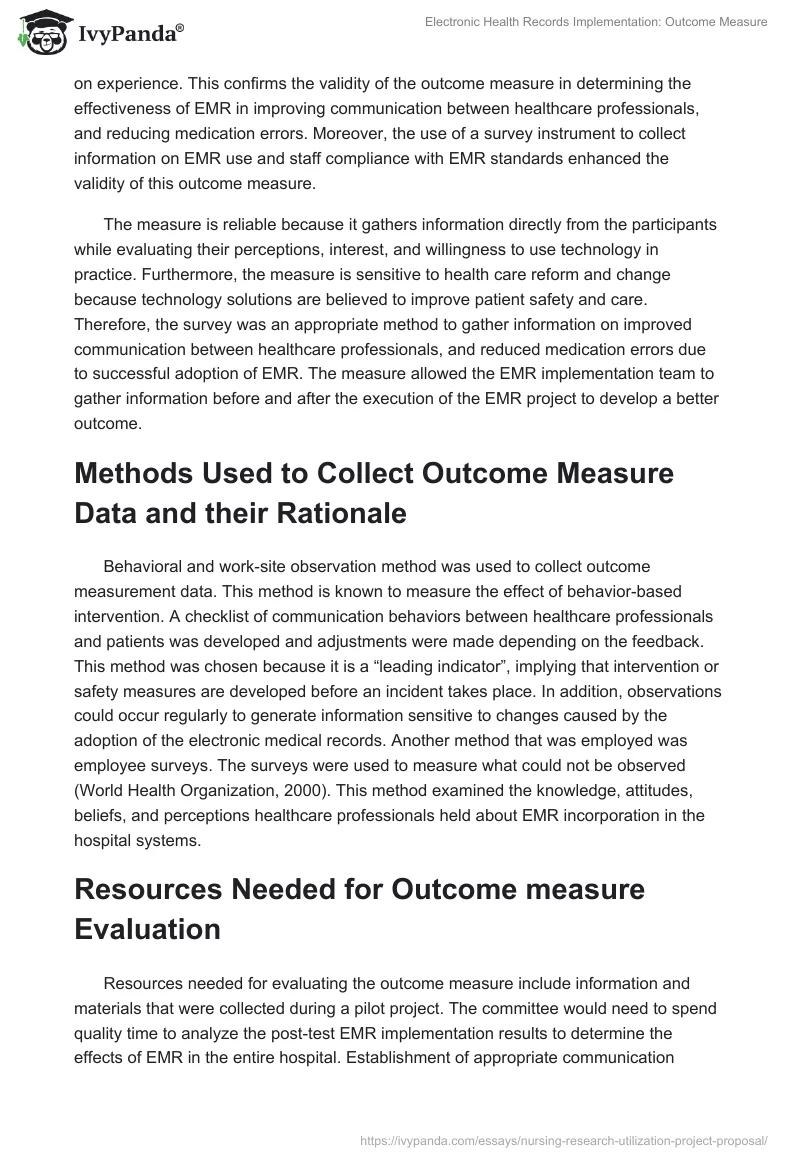- Section E: Outcome Measure
- How the Selected Outcome Measure Is Credible
- Methods Used to Collect Outcome Measure Data and Their Rationale
- Resources Needed for Outcome Measure Evaluation
- The Feasibility of the Evaluation Plan
- Two Grant Funding Sources
- Section F: Decision-Making Strategies
- Conclusion
- References
This section explains methods that were used to evaluate the process of electronic medical records implementation in the hospital. It also examines the outcome measure and shows how EMR discharge is reliable, sensitive to change, and appropriate for adoption.
Section E: Outcome Measure
The major objective of this project was to implement an electronic medical record system that would help healthcare professionals solve communication problems within the hospital. Thus, they would avoid medication errors that jeopardize patient care and safety. Before and after the analysis outcome measure was used to evaluate the progress of this project. Improved communication between physician-physician, physician-nurse, and nurse-nurse, and overall reduction of medication errors in the hospital would indicate positive outcomes.
The project manager will collect data from healthcare professionals using a survey questionnaire three months after the implementation of an EMR system. The questionnaire will be based on the effectiveness and challenges of using an EMR in practice. In addition, the survey will measure satisfaction or dissatisfaction with technology use within the hospital. Some of the survey questions will be scale type to measure participant perceptions about the EMR project, while others will require the participants to give either true or false answers (Brooks & Grotz, 2010). The outcome measurement tool is provided in the appendix.
How the Selected Outcome Measure Is Credible
The committee in charge of implementation, evaluation, and monitoring of the electronic medical records consisted of IT experts and healthcare professionals. Therefore, the criteria they used to develop the outcome measure survey were based on experience. This confirms the validity of the outcome measure in determining the effectiveness of EMR in improving communication between healthcare professionals and reducing medication errors. Moreover, the use of a survey instrument to collect information on EMR use and staff compliance with EMR standards enhanced the validity of this outcome measure.
The measure is reliable because it gathers information directly from the participants while evaluating their perceptions, interests, and willingness to use technology in practice. Furthermore, the measure is sensitive to healthcare reform and change because technology solutions are believed to improve patient safety and care. Therefore, the survey was an appropriate method to gather information on improved communication between healthcare professionals and reduced medication errors due to successful adoption of EMR. The measure allowed the EMR implementation team to gather information before and after the execution of the EMR project to develop a better outcome.
Methods Used to Collect Outcome Measure Data and Their Rationale
Behavioral and work-site observation method was used to collect outcome measurement data. This method is known to measure the effect of behavior-based intervention. A checklist of communication behaviors between healthcare professionals and patients was developed and adjustments were made depending on the feedback. This method was chosen because it is a “leading indicator”, implying that intervention or safety measures are developed before an incident takes place. In addition, observations could occur regularly to generate information sensitive to changes caused by the adoption of the electronic medical records. Another method that was employed was employee surveys. The surveys were used to measure what could not be observed (World Health Organization, 2000). This method examined the knowledge, attitudes, beliefs, and perceptions healthcare professionals held about EMR incorporation in the hospital systems.
Resources Needed for Outcome Measure Evaluation
Resources needed for evaluating the outcome measure include information and materials that were collected during a pilot project. The committee would need to spend quality time analyzing the post-test EMR implementation results to determine the effects of EMR in the entire hospital. Establishment of appropriate communication channels is also a vital resource needed for outcome evaluation. This would ensure that there is precise and clear presentation of data and results to enable the management make decisions for improvement. Other resources needed include qualified personnel, finances, and quality time. In addition, hardware and software resources will be required to ensure successful installation and functioning of the EMR system (EMR Evaluation Toolkit, 2009).
The Feasibility of the Evaluation Plan
The evaluation plan is feasible because it depends on the participant’s willingness to embrace change efforts initiated by the committee in charge of EMR adoption. Change of behaviors, attitudes, and beliefs towards technology will enable healthcare professionals to use EMR effectively and improve patient care. EMR post-implementation evaluation results will help the committee to identify areas that need improvement to enhance the effective use of an electronic medical record system to improve communication and reduce medication errors (Brooks & Grotz, 2010). Thus, the evaluation plan is feasible.
Two Grant Funding Sources
The funding sources include federal funding through the HITECH Act that allows healthcare facilities to receive approximately $19 billion to adopt EHR. The proposal is good for this funding because it corresponds with the government’s efforts to promote patient care (EMR Evaluation Toolkit, 2009). Another funding targeted is the $36 billion incentive payments made to physicians and hospitals. This funding is appropriate for this proposal because hospitals and physicians who demonstrate a desire to incorporate technology in practice and adopt EHR qualify for this fund.
Section F: Decision-Making Strategies
Maintaining the Solution
The committee in charge of implementing the electronic medical records will monitor staff compliance with technology for six months. Successful transition from paperwork records to technology records will reflect full compliance. However, any difficulties discovered with EMR use will be countered by continuous training.
Methods and Plans to Extend the Solution
Many healthcare facilities are committed to improving patient care through technology solutions. EMR reduces incidences of medication errors and patient dissatisfaction resulting from poor communication channels within the hospitals. Hospitals are ready to organize seminars for physicians and senior healthcare professionals to enlighten them about the importance of using EMR. This will extend the solution.
Methods and Plans to Revise a Successful Solution
Six months after EMR implementation, the committee will evaluate the incidence of medication errors and the quality of communication among healthcare professionals. If the rate of technology adoption and proficiency is slow, training schedules will be revised and a more simplified procedure will be adopted to enhance quick EMR adoption and use. EMR system experts will meet with the physician and the nurses to discuss possible challenges they faced for the last six months they have been using EMR so that appropriate revision will be initiated.
Methods and Plans to Terminate an Unsuccessful Solution
To terminate an unsuccessful solution requires one to evaluate the solution from the beginning to identify the root cause of failure. The committee in charge will discuss the impact of terminating the solution. If the reasons for terminating the solutions include lack of information technology in the facility, lack of finances, or employees’ reluctance to change and reform, then the committee may decide to communicate the termination request to the project coordinator to facilitate termination.
Plans for Work Setting and Professional Feedback
Communication or feedback in the work setting is crucial. The supervisors will inform the project coordinator about the progress of the project on a weekly basis. Moreover, public announcements will be made available on the hospital notice board to inform stakeholders about the progress of EMR project adoption. In addition, the project coordinator will publish the project results in the hospital’s quarterly newsletter and email them to the external stakeholders to update them on the progress of the project. Lastly, the committee may inform stakeholders, both internal and external, about the benefits of implementing EMR during annual general meetings (World Health Organization, 2000).
Conclusion
Poor communication within healthcare facilities results in medication errors, which threaten patient care and safety. However, successful implementation of EMR can improve communication between healthcare professionals as well as reduce the incidences of medication errors. Implementation of an EMR system is feasible because of support from the government (O’Malley, Cohen, & Grossman, 2010).
References
Brooks, R., & Grotz, C. (2010). Implementation of electronic medical records: How healthcare providers are managing the challenges of going digital. Journal of Business & Economics Research, 8 (6), 73-84.
EMR Evaluation Toolkit. (2009). EMR evaluation and planning toolkit. Web.
O’Malley, S, Cohen, R., & Grossman, J. (2010). Electronic Medical Records and Communication with Patients and Other Clinicians: Are We Talking Less? Web.
World Health Organization. (2000). Workbook7: Outcome Evaluation. Web.


